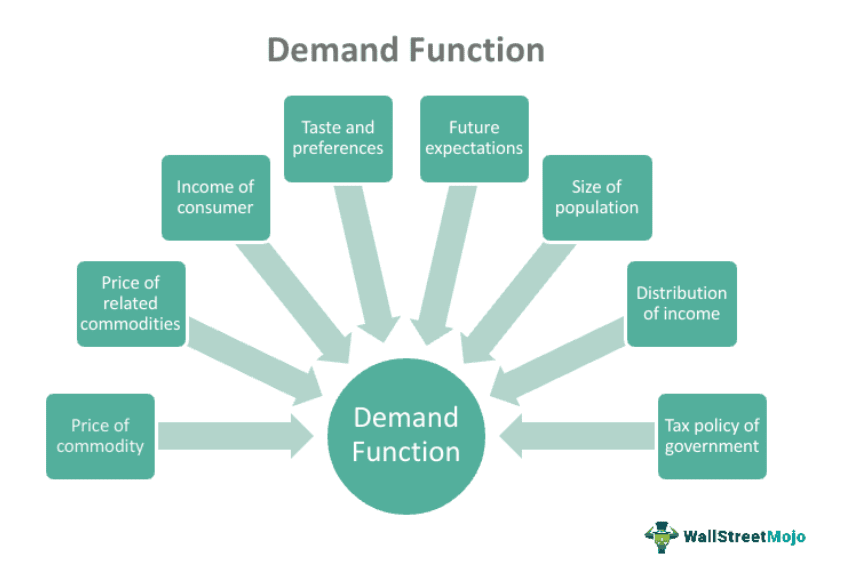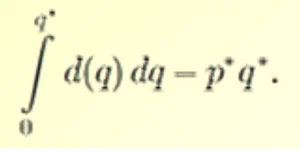What Is Demand Function?
A demand function is a mathematical function describing the relationship between a variable, like the demand of quantity, and various factors determining the demand. The purpose of this function is to analyze the behavior of consumers in a market and to help firms make pricing decisions.

You are free to use this image on your website, templates, etc, Please provide us with an attribution linkHow to Provide Attribution?Article Link to be Hyperlinked
For eg:
Source: Demand Function (wallstreetmojo.com)
Economists rely heavily on this function in their economic theories. Generally, a product’s demand acts as a variable affected by price. This function can assess the market stability and market-clearing cost. Therefore, it specifies the quantities and prices an individual or all customers are willing to buy and pay at any given time.
Table Of Contents
Key Takeaways
- The demand function definition refers to a relationship between a product’s demand and other determinants affecting it, like price.
- It is basically of two types – individual function of demand and market function of demand.
- An inverse function is a process where price becomes the function of demanded quantity. In addition, this helps determine the cost of the product which would maximize the profits.
- In addition, this function can be used to understand consumer behavior in a market and assist firms in making informed decisions about pricing, marketing, and resource allocation.
Demand Function Explained
The demand function, or the demand curve, describes the relationship between the quantity demanded by customers and the product price. Thus, the price of goods becomes vital in determining the number of goods consumers buy in a market. The most common form of this function is the linear demand function. However, economists often use different functional forms apart from the linear process, such as logarithmic and polynomial functions, to capture different consumer behavior patterns.
Moreover, the process of demand describes the relationship between the need for a product with that of other factors:
- Commodity demand: the demand for a commodity affects the item’s price either positively or negatively.
- Commodity function: the quality of a commodity affects demand.
- Goods or service prices: if the costs increase, demand decreases.
- The expected price of the commodity in the future: if the customers expect any change in their income or price change of a product, the demand changes.
- Related products and services price: if the substitute product’s price changes, then if the demand for the original product changes, one can say the product is related to each other as complement and substitute.
- Consumer’s pattern of taste: The company makes significant investments in advertising to change the taste and preference of consumers to like the advertised product.
We can refer to the above as the factors that affect demand. It occurs because various factors influence the market for any commodity. Furthermore, income is not a determinant in the Marshallian demand function. Economist Alfred Marshall gave his name to the Marshallian process of purchasing power. Therefore, the market researcher can calculate the slope and intercept of the economic demand function by forecasting how price or other economic factors affect the requirement for a specific product.
Financial Modeling & Valuation Courses Bundle (25+ Hours Video Series)
–>> If you want to learn Financial Modeling & Valuation professionally , then do check this Financial Modeling & Valuation Course Bundle (25+ hours of video tutorials with step by step McDonald’s Financial Model). Unlock the art of financial modeling and valuation with a comprehensive course covering McDonald’s forecast methodologies, advanced valuation techniques, and financial statements.
Types
We can attribute the basis of these function types to either individual customers or the entire set of consumers in the market. Below listed are the types of functions:
#1 – Individual Demand Function
The Individual function of demand means the functional relationship between a particular need for a product and all the factors that affect it. Moreover, it also explains the relationship between the market’s direction and its aspects. In addition, companies can calculate this function by using data on consumer buying behavior, such as surveys, market research, or sales data. Therefore, this function is derived from individual consumers’ preferences, income, and other characteristics of individual consumers. Consequently, it helps understand consumer behavior in response to changes in price.
#2 – Market Demand Function
The market function of demand means the existing functional relationship between the need of the market and the factors affecting the market demand. Besides those factors affecting the individual demand process, the magnitude, and structure of climatic conditions and income distribution also affect the demand’s market function.
Subsequently, evaluating this function involves using data on the prices and quantities demanded by all buyers in the market. Therefore, this data can be obtained from market research, surveys of buyer behavior, and sales records. Hence, this function evaluates the market stability price and quantity, which is the point where demand meets supply.
Formula
This function can be calculated using two different formulas since it indicates the relation between the demand level and other factors influencing the demand. One can differentiate between the individual and market demand for goods or products.
#1 – Individual Demand Function
Algebraically, the individual function of demand is described as follows:
Dx = f (Px, I, Pr, E, T)
- The Demand of Commodity x (Dx)
- The function of product x (f)
- Price of good or service (Px)
- Incomes of buyers (I)
- Prices of related goods & services (Pr)
- The future expectation of the product (E)
- Taste patterns of buyers (T)
#2 – Market Demand Function
Algebraically, the market function of demand is described as follows:
Dx = f (Px, Y, Py, Ep, T, Pp, A, U)
- The demand of Commodity x (Dx)
- The function of commodity x (f)
- Price of good or service (Px)
- Incomes of buyers (Y)
- Prices of related goods & services (Py)
- The Expected future price of the product (Ep)
- Taste patterns of users (T)
- Number of buyers in the market (Pp)
- Distribution of Income (A)
- Government Policy (U)
Examples
Let us look at the examples to understand the basics of the topic.
Example #1
Assume John is looking to buy a new pair of shoes. He has a $100 budget and is willing to spend up to $50 on shoes. However, he will reduce his demand for purchasing shoes if the price rises above $50.
He also considers the shoes’ style and comfort as a demand determinant. If the boots are comfortable, He would agree to pay more for them. In contrast, he would refuse to pay if it did not meet his needs.
As a result, in this example, John’s demand for shoes is influenced by several factors, including his budget, the cost of the shoes, and his preference for style and comfort. As a result, the demand curve that captures the relationship between the quantities of shoes demanded and the factors influencing demand can be estimated.
Example #2
Assume that according to Amacon’s market research, which examines how consumer demand works in the luxury car market. The study examines luxury car sales and pricing data to determine how price changes affect consumer demand for various models. The market researcher also assesses how brand reputation, performance, and features influence consumer preferences and purchasing behavior in the luxury car market. Finally, it shows an instance of using this function to analyze consumer behavior and purchasing decisions in a specific market.
Inverse Demand Function
Sometimes an independent variable like price defines the demand curve, so one calls it an inverse function of demand. The inverse function of demand helps find that additional income is created when one extra unit gets sold. The marginal revenue function creates the first derivative for the inverse demand process. Moreover, price becomes the function of direction in quantity here. Under this, price becomes the function of the commodity demanded.
It is essential because:
- It aids in calculating the impact when the quantity demanded changes to the price.
- It helps assess the amount of product that will help maximize profit.
Frequently Asked Questions (FAQs)
The aggregate function of demand refers to an economic concept that shows the total demand for goods and services within an economy at a given price level for a specific period.
To find the marginal revenue from this function, one has to differentiate the total revenue function for the quantity, which is the product of price and quantity. The formula of marginal revenue function is:
MR = dTR/dQ,
MR is the marginal revenue, TR is the total revenue, and dQ is the demand derivative.
Consumer surplus is the difference between the maximum price a consumer is willing to pay for a product and the actual price they pay. To find the consumer surplus from this function, follow the below steps:
Let there be a function of demand p = d(q),
A supply function is given as p= s(q),
And the equilibrium point be demoted as (q*, p*
Therefore the consumer surplus formula is as follows:
Recommended Articles
This article has been a guide to what is Demand Function. Here, we explain the topic with its formula, inverse demand function, examples, and types. You may also find some useful articles here –



Find notes quite helpful